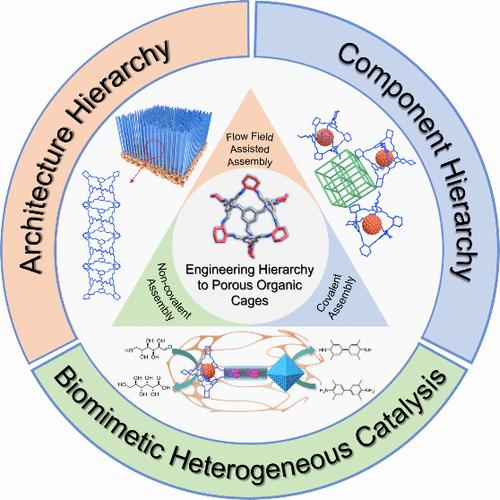Engineering Hierarchy to Porous Organic Cages for Biomimetic Catalytic Applications
IF 14
Q1 CHEMISTRY, MULTIDISCIPLINARY
引用次数: 0
Abstract
In nature, hierarchy is a core organizational principle intricately woven into biological systems, facilitating the compartmentalization of enzymes within living cells. This spatial arrangement enables multistep metabolic reactions to occur simultaneously with remarkable efficiency and precision. Inspired by this, significant progress has been made in artificial biomimetic heterogeneous catalytic systems using porous materials like metal–organic frameworks, porous organic polymers, and zeolites. Among these, molecular cages, with their well-defined cavities, stand out as synthetic models for enzyme-mimic catalysis. They not only provide biomimetic microenvironments for substrate binding, mimicking the highly specific and efficient interactions observed in natural enzymatic systems, but also integrate active centers within confined nanoscale spaces, enabling synergistic functionality. However, research in cage-based biomimetic catalysts has largely focused on tailoring the cavity environment─such as optimizing cavity size, pore geometry, and functional groups on the pore walls─to regulate catalytic processes, while comparatively less attention has been given to the catalytic role of metal centers, akin to the critical function in natural metalloenzymes. While metal nodes in metal–organic cages can act as active sites, their catalytic efficiency may be hindered by coordination saturation. Moreover, the restricted (sub)nanoscale space of molecular cage reactors limits their capacity to host larger active sites or accommodate bulky substrates. Thus, rationally engineering the confined spaces and optimizing the spatial arrangement of active sites within molecular cage-based catalytic systems is essential for advancing the field and unlocking their full potential.

仿生催化应用的多孔有机笼的工程层次
在自然界中,等级制度是一个核心的组织原则,复杂地编织在生物系统中,促进活细胞内酶的区隔。这种空间安排使多步代谢反应能够以惊人的效率和精度同时发生。受此启发,使用多孔材料如金属有机框架、多孔有机聚合物和沸石的人工仿生非均相催化系统取得了重大进展。其中,分子笼,具有明确的空腔,作为模拟酶催化的合成模型脱颖而出。它们不仅为底物结合提供了仿生微环境,模仿了在天然酶系统中观察到的高度特异性和高效的相互作用,而且还将活性中心整合在有限的纳米尺度空间内,从而实现协同功能。然而,基于笼型仿生催化剂的研究主要集中在调整空腔环境(如优化空腔大小、孔几何形状和孔壁上的官能团)来调节催化过程,而相对较少关注金属中心的催化作用,类似于天然金属酶的关键功能。虽然金属有机笼中的金属节点可以作为活性位点,但它们的催化效率可能受到配位饱和的影响。此外,分子笼反应器有限的(亚)纳米级空间限制了其承载更大活性位点或容纳大体积底物的能力。因此,合理设计密闭空间,优化分子笼型催化体系中活性位点的空间排列,对于推进该领域的发展和释放其全部潜力至关重要。
本文章由计算机程序翻译,如有差异,请以英文原文为准。
求助全文
约1分钟内获得全文
求助全文

 求助内容:
求助内容: 应助结果提醒方式:
应助结果提醒方式:


